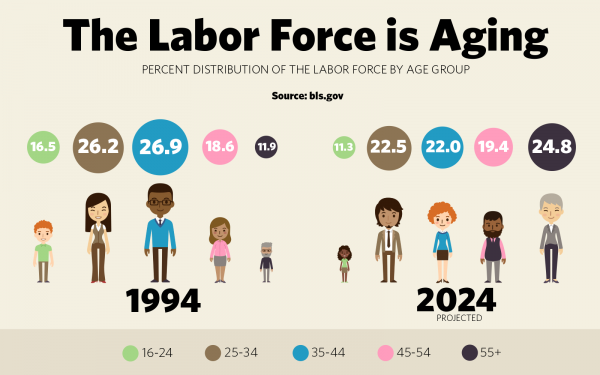ATD Blog
Managing the Modern, Mobile Federal Workforce
Thu Nov 16 2017

Nobody ever said that being a supervisor in today’s federal workplace was easy. Most are faced with being working managers in fast-paced environments with dwindling resources, leaving very little time to focus on the hands-on management tactics that traditional leadership training and development programs recommend.
So what are some short cuts that leaders can consider implementing to drive powerful results? Here’s what some of the most engaged federal leaders are saying about managing today’s multigenerational workforce in the modern, mobile workplace.
Flexible Options/Flexible Choices
The multigenerational workforce presents one of the biggest challenges facing today’s leadership. The Bureau of Labor and Statistics estimates that by the year 2025, nearly 25 percent of the workforce will be older than the age of 55. Managers are looking at leading teams that range in age from student employees to those beyond post-retirement. With drastically different skillsets, levels of expertise, communication styles, workplace and technology preferences—federal leaders must ensure that their management skills are flexible and customizable to meet their diverse team’s needs.

One of the easiest ways to get started is by offering a variety flexible work arrangements to employees. Options range from telework and virtual work assignments to alternate or compressed work schedules to even part-time positions or job-sharing options. Federal leaders are recognizing significant benefits of maximizing employee engagement by allowing choice and autonomy in how, when, and where their employees perform their best work.
The U.S. Office of Personnel Management and U.S. Government Accountability Office cite employee satisfaction with work-life balance as one of the five key drivers of employee engagement, and engaged leaders understand that work is what you do, not where you go.
The most effective leaders recognize that allowing employees the ability to choose from a suite of flexible work policies that are best-suited for their diverse preferences, skills, and competencies will result in increased productivity, enhanced retention rates, and more effective recruitment prospects.
Teaming Technology
Even in the public sector, our organizations understand the competitive advantage of adapting to the gig economy model of work by leveraging new and emerging technology and analytics tools. But for leaders who manage people in today’s rapidly changing environment, introducing these new and emerging technologies can create a challenge. Their teams of employees bring different levels of comfort with the adoption of new technology in the workplace, and many then turn to early adopters who can help serve as peer mentors for creating an easier transformation to new and more efficient ways of working. Indeed, creating a team-based approach in the workplace can help enhance collaboration, communication, and innovation across teams.
How do you do this? Tech-savvy managers know that enabling their teams with the right kinds of technology will only work if the cultural norms they encourage create a “practice makes perfect” environment. Creating a work culture that embraces learning and trying new tools will only work successfully if employees also have permission to fail and learn from those failures. Communicating the right kinds of performance expectations is key to getting this right.
Focus on the Future
Now more than ever, today’s government agencies are working to empower leaders of today and tomorrow with the skills they’ll need to effectively manage the evolving demands of the modern, mobile workforce.
Creating a culture of excellence in today’s workplace requires a different way of thinking about leadership development and talent management. Emerging training and development programs are shifting from traditional methodologies to an expanded focus on executive skills that support long-range career growth. This can help organizations develop a better understanding on how leaders can support long-term career growth while maximizing the performance and engagement of their workforce.
Our federal practitioners are also considering how to create more effective assessment tools that result in selecting future leaders who can effectively navigate the complexities of the modern, mobile workplace. The competencies required for effective are frankly not the same as those that did a decade ago.
As we continue to focus on the future of our organizations and how we will organize, recruit, develop, and engage the federal workforce, the question becomes how we will continue to select and develop the right types of people who will fill our government’s emerging leadership roles.
You've Reached ATD Member-only Content
Become an ATD member to continue
Already a member?Sign In
